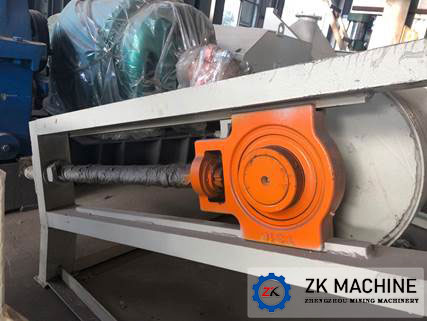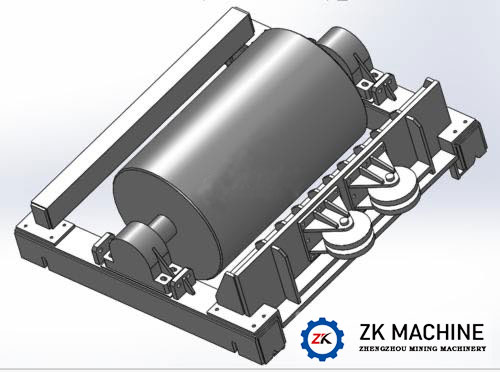Tensioning Device of Belt Conveyor
Date:2020-09-21 Source:zk corp Views:
The role of the belt conveyor tensioning device is to ensure that the conveyor belt has a certain tension, so that the necessary friction between the conveyor belt and the roller is generated; to limit the sag of the conveyor belt between the supporting points, and to make the conveyor run normally. There are three types of tensioning device: spiral, cart and vertical. It is best to install it at a guide roller with a wrap angle equal to 180 ° and a smaller tension.

1. Spiral tensioning device
The spiral tensioner is shown in the figure. The main parts are the bearing seat for installing the roller, the screw for adjusting the position of the bearing seat and the bracket with guide rail. The roller can rotate freely in the bearing seat, and rotating the screw can make the bearing seat slide along the support rail to adjust the tension. The screw should be self-locking to prevent loosening.
The screw-type tensioning device is compact and light, with a small footprint and easy installation, but the tension and stroke are small and cannot be automatically adjusted. It is suitable for working environments with little temperature and humidity changes and a light type belt conveyor with a length of less than 80 meters and a small power. The stroke of the spiral tensioning device is generally selected according to 1% of the conveyor length, and its stroke has two types: S=500mm and S=800mm.
2. Car-type tensioning device
The car-type tensioning device is generally installed at the end of the belt conveyor, and the tensioning purpose is achieved by traction of the roller by the falling weight. The car-type transmission device has a simple and reliable structure and is suitable for long-distance, high-power belt conveyors. However, it has poor working stability when the load branch tension changes (caused by changes in feeding, unloading and supporting resistance).
3. Vertical tensioning device
The vertical tensioning device is usually installed on the unloaded branch near the transmission drum, and it is less sensitive to changes in the resistance of the loaded branch. At the same time, the tension there is close to the minimum value, which can reduce the tension and fall. Vertical tensioning devices are often used on long-distance, high-power inclined or overhead conveyors with belt corridors. The advantages of the vertical tensioning device are stable work, large tensioning force and tensioning stroke, and the space position of the conveyor corridor is utilized for easy layout. The disadvantage is that there are many reversing rollers, and the tape continuously produces different directions of bending, which reduces the service life of the tape; and the material is easy to fall between the conveyor belt and the tension roller. When conveying materials with high wet viscosity, vertical tensioning is not suitable to use the tight device.


